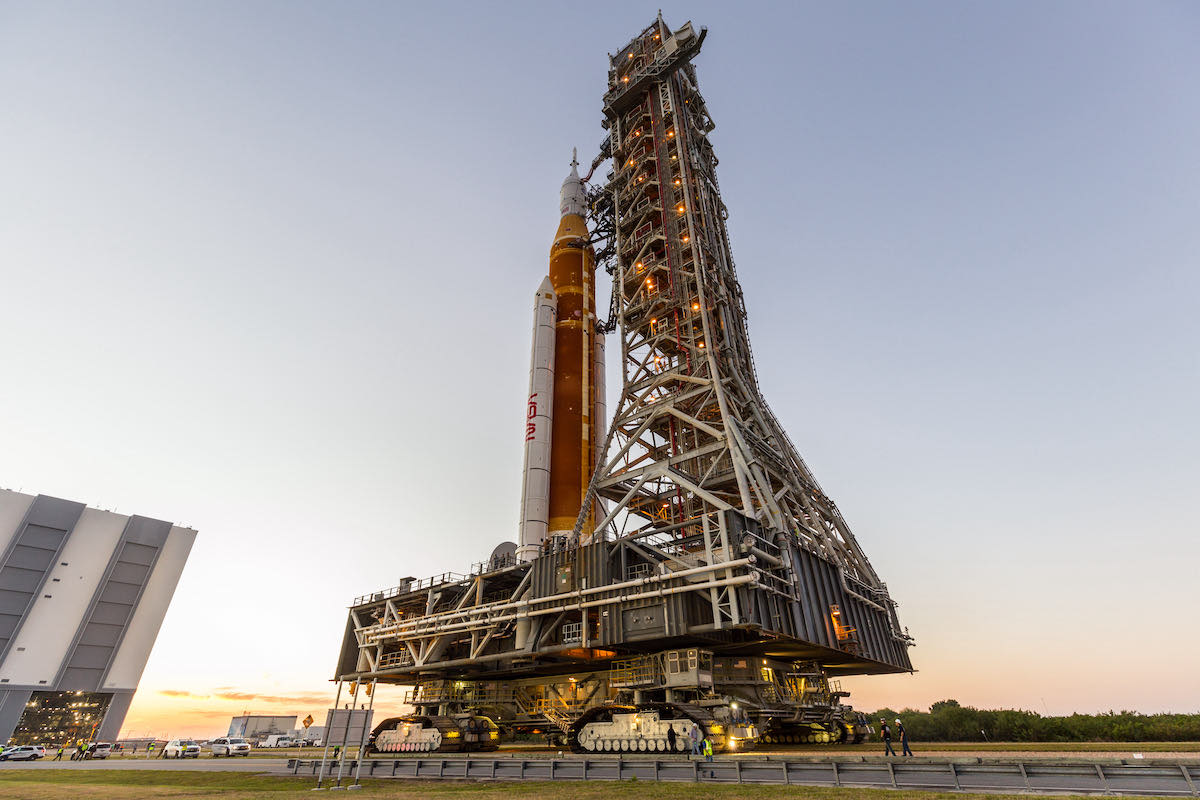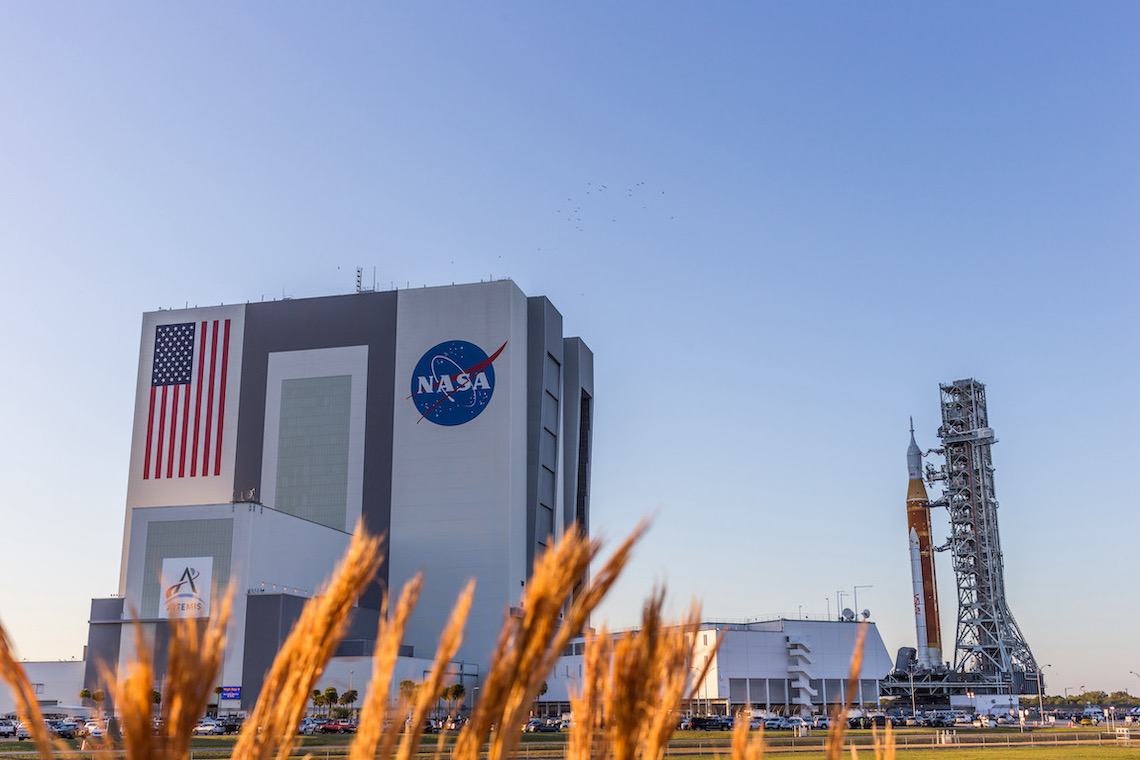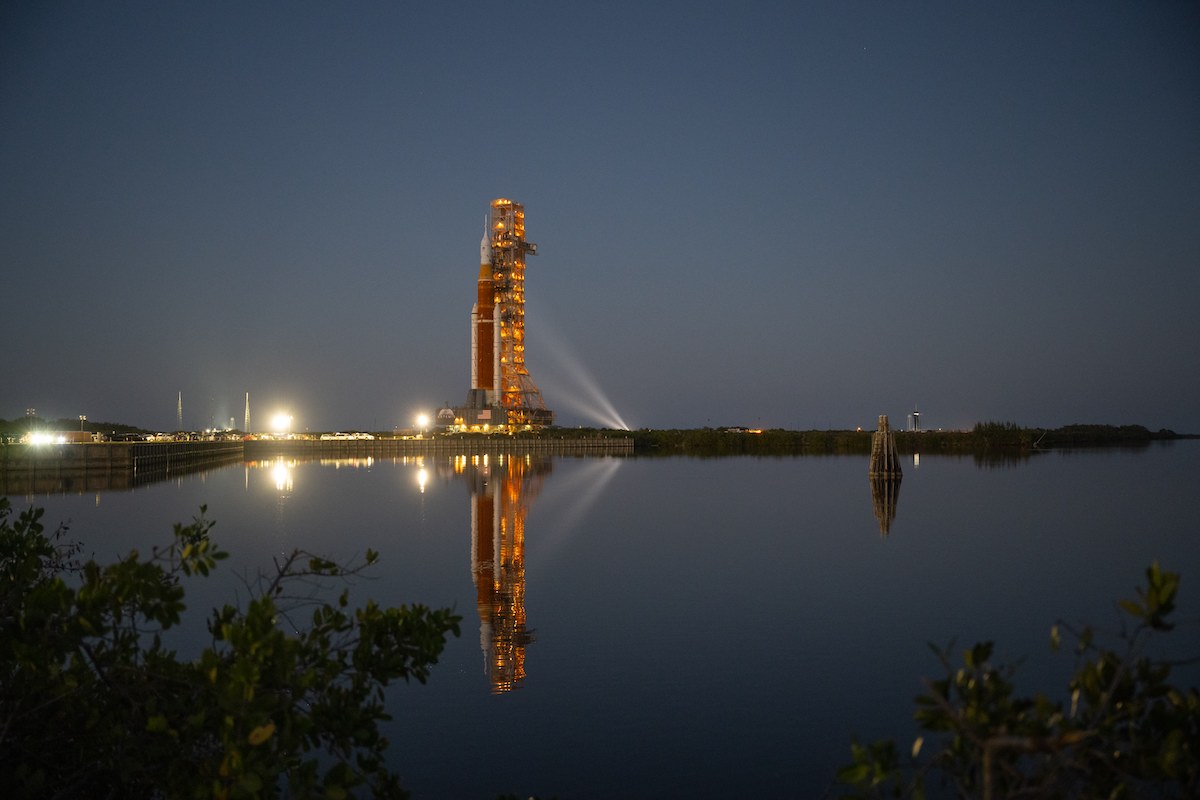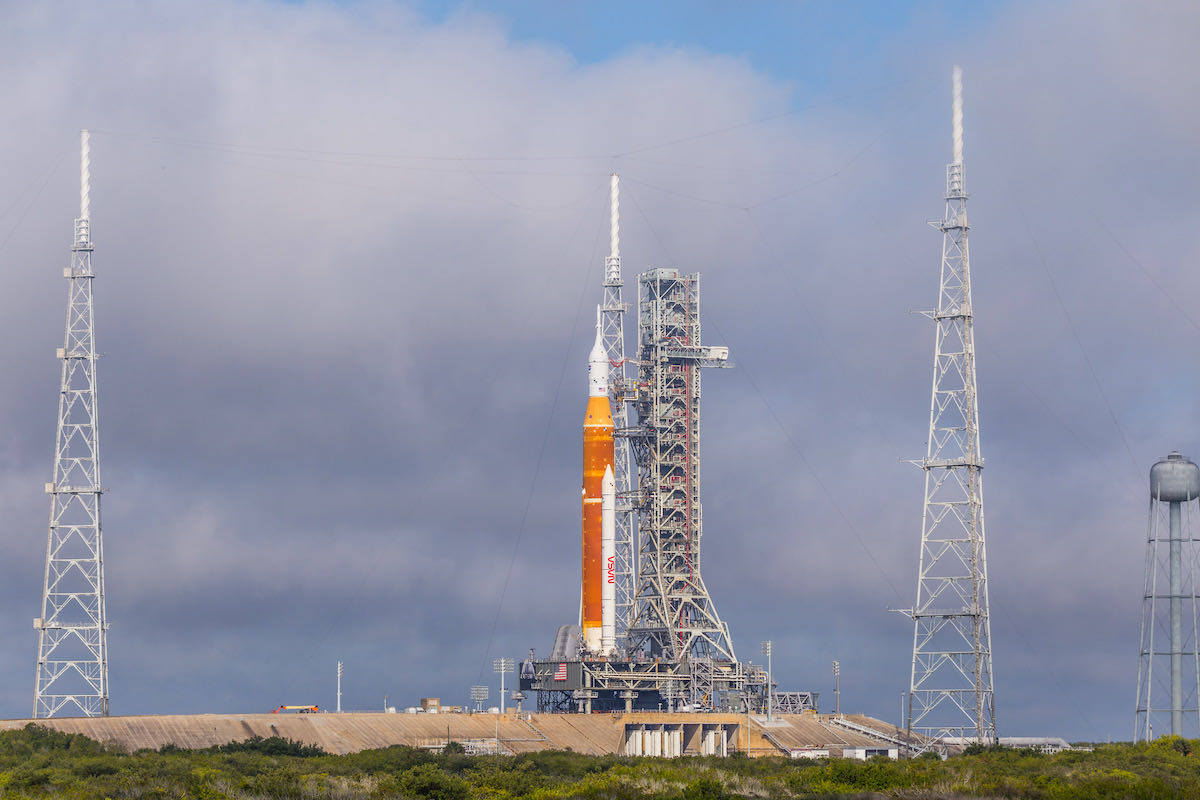Space News & Blog Articles
NASA’s most powerful rocket moved to launch pad for first time
 NASA’s Space Launch System rolls eastbound toward pad 39B. Credit: Alex Polimeni / Spaceflight Now
NASA’s Space Launch System rolls eastbound toward pad 39B. Credit: Alex Polimeni / Spaceflight Now
NASA’s powerful new moon rocket, standing more than 30 stories tall, arrived on the launch pad early Friday for the first time at the Kennedy Space Center in Florida, ready for a series of checkouts culminating in fueling test and simulated countdown in early April.
The Space Launch System is designed to launch astronauts to the moon for the first time since the last of NASA’s Apollo lunar missions in 1972. NASA is preparing the first SLS, along with an Orion crew capsule on top, for an unpiloted test flight to lunar orbit later this year.
The test flight will pave the way for future launches carrying astronauts, culminating in landings on the moon later this decade.
The 322-foot-tall (98-meter) rocket, standing atop its mobile launch platform, emerged from High Bay 3 of the Vehicle Assembly Building Thursday evening. The rollout began at 5:47 p.m. EDT (2147 GMT) aboard one of NASA’s refurbished crawler-transporters, the tracked, diesel-powered vehicles originally built for the Apollo program in the 1960s.
Crowds of employees, VIPs, and news media gathered outside the VAB to witness the historic rollout, marking the public debut of the Space Launch System. The rocket is the most powerful, in terms of total thrust, ever built by NASA, exceeding the Apollo-era Saturn 5 moon rocket and the space shuttle.
It’s nearly twice the height of the space shuttle in launch configuration, but about 40 feet shy of the towering Saturn 5.
The crawler stopped just outside the doors of the VAB to allow the Orion spacecraft’s crew access arm to move away from the rocket. The arm is unable to be retracted inside the high bay due to structural clearance restrictions.
Teams stopped the rollout another time to gather data on the entire stack’s response to the deceleration. The data will help inform models on the structural stiffness of the stack.
The rollout then resumed and the crawler reached a top speed of around 0.8 mph before moving up the ramp to pad 39B. The crawler lowed the mobile launch platform onto pedestals at the pad around 4:15 a.m. EDT (0815 GMT) Friday.
 Credit: Alex Polimeni / Spaceflight Now
Credit: Alex Polimeni / Spaceflight Now
The crawler-transporter was upgraded to handle the weight of the SLS with its mobile launch platform. The entire stack, including the crawler, mobile launch platform, and the Space Launch System, weighed around 21.4 million pounds during the 4.2-mile (6.8-kilometer) journey.
NASA’s two crawlers were built in the 1960s by Marion Power Shovel Company of Ohio. Over the last decade, Crawler-Transporter 2, which has logged 2,335 miles (3,758 kilometers) in its lifetime, was outfitted with new diesel engines and power generators made by Cummins, and modified to support the heavier load of the SLS.
Technicians also replaced roller assemblies and bearings with hardware designed for a greater load capacity. Other upgrades included a new lubrication system, new jacking and leveling cylinders, a new driver control and monitoring system, new brakes, and reconditioning of the crawler’s gear cases and gears, according to NASA.
The modifications are intended to extend the service life of the crawler by 20 years.
“While the original crawler was over 50 years ago, we have done significant upgrades in preparation for rolling this vehicle to the pad and for Artemis operations,” said Charlie Blackwell-Thompson, NASA’s Artemis 1 launch director.
With the SLS and Orion spacecraft now on pad 39B, ground crews have kicked off preparations for a countdown dress rehearsal in early April, when the launch team will load super-cold liquid hydrogen and liquid oxygen propellants into the rocket’s Boeing-built core stage and upper stage, made by United Launch Alliance.
If the test goes well, NASA will return the rocket to the VAB later next month for additional launch preparations, then roll the SLS back to pad 39B for launch on the Artemis 1 mission, the first test flight of NASA’s program to return astronauts to the moon.
Ground teams at Kennedy will spend about two weeks preparing for the SLS countdown dress rehearsal. The two-day simulated countdown is scheduled to begin April 1, culminating in the loading of liquid hydrogen and liquid oxygen on Sunday, April 3.
“We only have about five or six things we have to do, but of course those five or six things are fairly complicated,” Blackwell-Thompson said.
Technicians will connect the mobile launch platform with the launch pad’s data, power, purge, and propellant lines, then begin validation tests to ensure the connections are good. That will be followed by communications testing at the launch pad, and tests to characterize the electromagnetic environment with the rocket at the pad.
Crews will load hydrazine into the the hydraulic power units on each of the two side-mounted solid rocket boosters. The boosters, built by Northrop Grumman, are extended versions of the boosters that flew on the space shuttle, and they reuse rocket motor casings left over after the shuttle retired.
The booster hydraulics power the thrust vector control steering system at the base of each booster.
During the countdown dress rehearsal itself, currently set for April 3, the countdown clock will stop at about T-minus 10 seconds, just before the four RS-25 main engines would ignite on the crew stage.
Then the launch team will drain the rocket of liquid propellants and prepare the rocket to roll back to the VAB around April 11, assuming the dress rehearsal goes smoothly.
 The Space Launch System heads toward pad 39B. Credit: Michael Cain / Spaceflight Now / Coldlife Photography
The Space Launch System heads toward pad 39B. Credit: Michael Cain / Spaceflight Now / Coldlife Photography
Since the last space shuttle sat on pad 39B in 2009, NASA tore down the pad’s fixed and rotating service structures and upgraded the facility for the new heavy-lift rocket. The SLS umbilical tower, fitted with multiple retractable arms to connect with the rocket, sits on the new Mobile Launcher carried to the pad on the crawler-transporter.
Without a mobile service gantry, the rocket is exposed while sitting on pad 39B. But the rocket has a wind damper and is designed to withstand any rain or winds that might blow through the spaceport.
“Obviously, if you get extreme weather, there’s always a concern what extreme weather, hail or something, could possibly do,” said Cliff Lanham, NASA’s flow director for the Artemis 1 mission. “But all in all, the routine weather that we’ll see, rain and some winds, we’re ready for it.”
The rocket’s return to the VAB after the wet dress rehearsal will set the stage for final work on the vehicle’s range safety destruct system, which would be used to destroy the rocket if it veered off course after liftoff. After other closeouts and tests, the rocket will return to pad 39B for the Artemis 1 launch countdown.
The launch is currently scheduled for no earlier than June. The mission has a 10-day launch period from June 6 to June 16, and another window opens June 29.
The SLS test flight is a milestone in a 10-year development that started in 2011, when Congress ordered NASA to design and build a gigantic rocket using technology left over from the agency’s retired fleet of space shuttles. NASA awarded Lockheed Martin the contract to develop the Orion spacecraft in 2006 under the umbrella of the agency’s Constellation moon program, which was canceled in 2010.
The rocket will launch the Orion spacecraft on a multi-week demonstration mission. The capsule will enter a distant retrograde orbit that moves in the opposite direction of the moon’s rotation, allowing NASA mission controllers at the Johnson Space Center in Houston to check out the craft’s performance before the agency commits astronauts to fly on the Artemis 2 mission.
The exact duration of the Artemis 1 mission depends on when the launch occurs in the month-long lunar cycle. The Orion capsule will return to a parachute-assisted splashdown in the Pacific Ocean off the coast of California.
 NASA’s Space Launch System on pad 39B. Credit: Alex Polimeni / Spaceflight Now
NASA’s Space Launch System on pad 39B. Credit: Alex Polimeni / Spaceflight Now
NASA kept the Orion program alive through two major restructurings of the agency’s deep space exploration efforts, first during the Obama administration, when Congress and the White House agreed to pivot NASA’s focus to a human mission to Mars, with an interim crewed expedition to an asteroid.
The Trump administration shifted NASA’s exploration program back to the moon. NASA dubbed the moon program Artemis, naming it for the twin sister of Apollo in Greek mythology.
Through it all, the Orion program survived. NASA’s inspector general reported last year year that the agency has spent $12.8 billion developing the Orion spacecraft since 2012, plus an additional $6.3 billion committed to the program in the prior decade under the Constellation program.
The Artemis 1 mission will be the second spaceflight of an Orion capsule, and the first mission to fly an Orion spaceship to the moon. It’s the first flight of the Orion spacecraft’s European-built service module, which provides electricity and propulsion for the capsule in deep space.
NASA’s inspector general said last year that the agency has budgeted $18.8 billion for the SLS program since 2012. Another $4.8 billion in the same period went toward readying Kennedy Space Center’s ground infrastructure for SLS and Orion missions.
This email address is being protected from spambots. You need JavaScript enabled to view it. the author.
Follow Stephen Clark on Twitter: @StephenClark1.
When you subscribe to the SpaceZE News Feed, we will send you an e-mail when there are new updates on the site so you wouldn't miss them.

